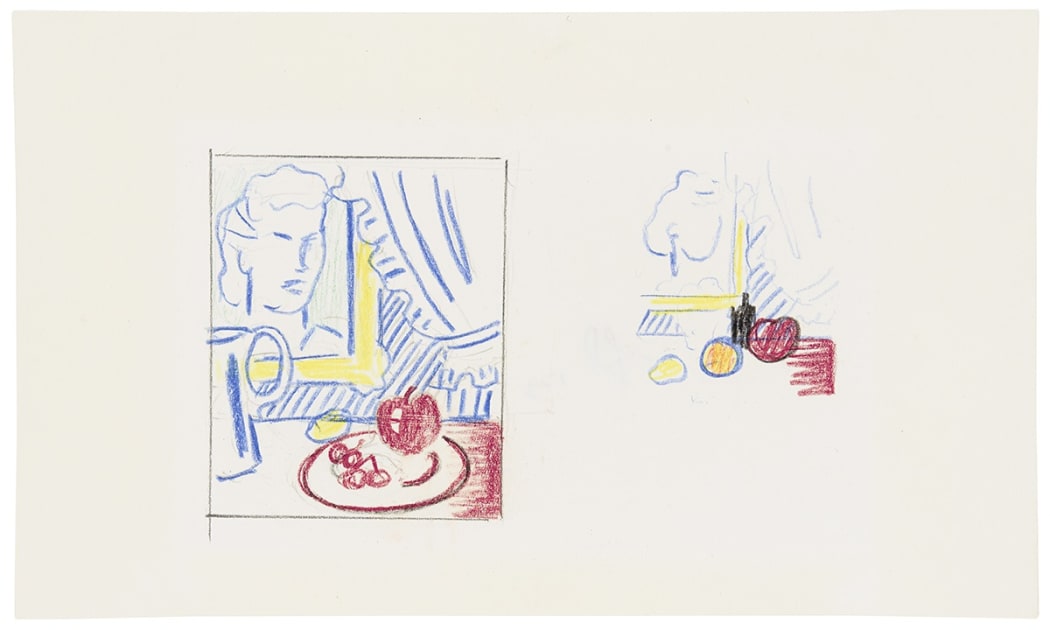
Preparatory Drawings
Preparatory drawings are arguably just as interesting as their final creations. These initial sketches, with their revisions, doodles, notes, instructions and scrawls, often offer a more intimate insight into the creative process and development of different designs. Skeleton drawings often show the imperfections, the workings and revisions that can make us feel closer to the mind of the maker, revealing a more vulnerable impression through the artist’s exploration of proportion, composition, depth, design. Tender pencil workings often have an intimacy that the final, more polished product doesn’t.
Roy Lichtenstein’s ‘Still Life with Portrait’ (1974) Study
This study of ‘Still Life with Portrait’ (1974) from Roy Lichtenstein’s Six Still Lifes series uses coloured pencil on paper. In contrast to the finalised lithograph screenprint with its smooth appearance, crisp colour contrasts and sharp definition, the accompanying study shows two preliminary stages. On the right, a partially complete sketch reveals a collection of objects on the table. This combination of items changes on the left from an apple, orange, lemon and little black bottle to an apple, four cherries, plate and lemon. The study on the left shows workings on the plate in graphite pencil where Lichtenstein was evidently considering and trialling the placement of the cherries. The final iteration changes once more to feature two lemons, an apple, five cherries and a plate. It is this evolution of the preparatory process that reveals trial and error re-workings, drawing us closer to Lichtenstein’s psyche during development.
Notes and Marginalia
Preparatory drawings depict an earlier stage of the process through the exploration of ideas, concepts and designs when configuring and trialling proportions, colour, depth and shading. Often the understudy drawings included texts, rough notes and scrawls as a conversation between the artist and him/herself with instructions, reminders, preliminary thoughts scribbled in the margins.
‘Industry and the Arts’ (1969)
Lichtenstein’s work ‘Industry and the Arts’ (1969) is divided in two to separate the ‘Industry’ elements from the ‘Arts’. The study on the right in a graphite pencil on paper has a loose, rough sketchiness that starkly contrasts with the preparatory drawing on the right with the thin, precise clarity of its line. The study on the left moves closer to the final version with faint pencil lines beneath the design revealing the drafting decisions made by Lichtenstein. A faint curved edge behind the aeroplane reveals the revised edge of the rudder that has been modified.
In the final screenprint, Lichtenstein’s use of colour (primarily blue and white on the ‘Industry’ side and a lively jostle of primary colours to illuminate the ‘Arts’) polarises the two sectors. The monochrome effect of these initial pencil sketches removes the colour distinction between the two.
‘Preparedness’ preliminary study
This preliminary study for ‘Preparedness’ which was created in 1968, demonstrates the thought process behind the complex design. The depiction of military machinery was made into a large wall-size oil and acrylic painting. In this preliminary sketch, Lichtenstein has used the margins to sketch and experiment with different angles of the soldier’s face and profile in the top margin, with evidence of crossing out, re-working, re-layering his ideas. The bottom margin shows the soldiers’ hands holding machinery, a reminder of the mortal men behind the warfare.
Study of Still Life with Picasso (1973)
This study of Still Life with Picasso (1973) shows Lichtenstein’s initial plans for the final print, rendered in graphite pencil and coloured pencil on paper. Whilst the final print uses commercialised Benday dots to define shadows and shading, loose pencil strokes are used here.
The process of the preparatory drawing allowed an artist to become familiar with their subject; to play around with possibilities. They offer an intimacy into the artist’s creative process; a behind-the-scenes peek into their decision making and methodology as they map out their ideas. There’s a freeness to the studies and sketches, a directness in the discovery as we observe the instinctive insights of their artistic process.
For more information on Roy Lichtenstein prints for sale, contact sales@andipa.com or call +44 (0)20 7589 2371 for more information.
